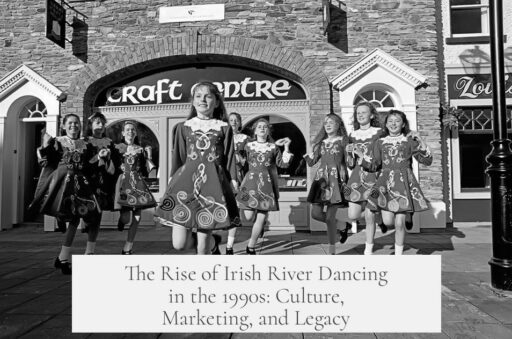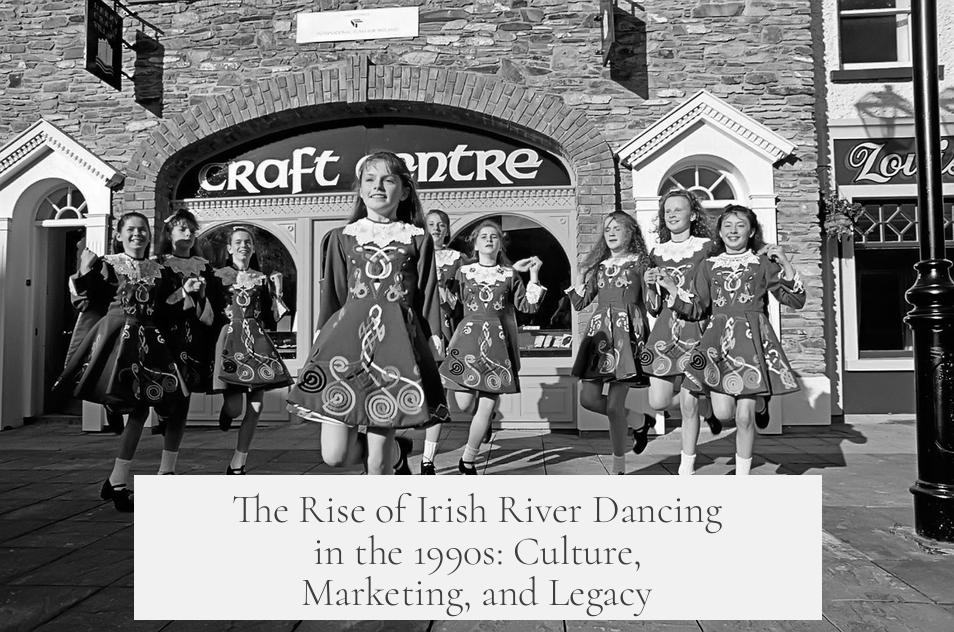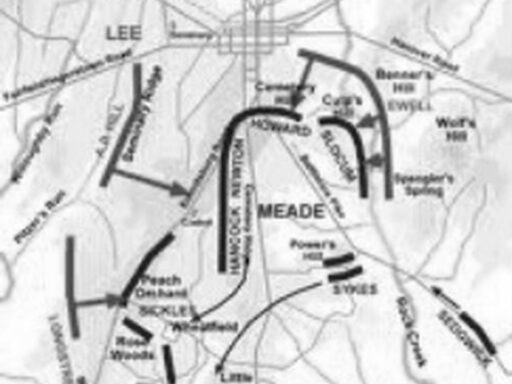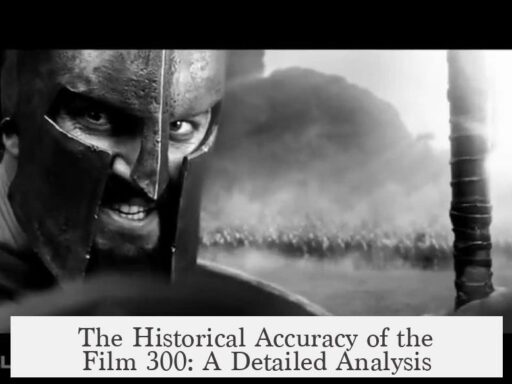Irish river dancing exploded in popularity during the 1990s due to a combination of cultural revival, strategic exposure, economic growth, and global marketing that transformed an underground tradition into a worldwide phenomenon.
Irish step dancing has deep roots, but it endured centuries of suppression, especially in the Penal Days starting around the 1600s, when authorities restricted Irish cultural expression. Despite this, some formal recognition of Irish dance emerged by the 1750s amid the Gaelic Revival. Traditionally, the dance involved jigs and reels performed solo or in groups called ceili, often linked to folk melodies and stories. Before Riverdance, Irish dance thrived mostly within local competitive circuits, highlighted by the annual World Championships (Oireachtas Rince na Cruinne), overseen by An Coimisiún Le Rincí Gaelacha (CLRG), an organization founded in 1927 to unify Irish dance interests.
Even though Irish dance had a passionate following, it wasn’t seen as mainstream or glamorous. Riverdance, first performed as an interval act during the 1994 Eurovision Song Contest in Dublin, changed that. The show took traditional rhythms and used bright costumes, dramatic choreography, and modernized music to make the dance captivating and accessible to global audiences. The combination of a world-class cast of champions, exceptional musicianship, and Anuna’s soaring vocals created a powerful performance.
- Riverdance debuted at Eurovision during a period when Ireland dominated the competition, having won multiple times consecutively.
- The 1994 event was held at Dublin’s Point arena on the city’s docklands, symbolizing urban renewal, making Riverdance a metaphor for both cultural and economic growth.
- This timing coincided with the Celtic Tiger economic boom in Ireland, which fueled national pride and global interest in Irish culture.
Michael Flatley, an Irish-American dancer, became integral to popularizing the show beyond Europe. His charisma and showmanship helped make Irish river dancing appealing in the United States, a country with a large population celebrating Irish heritage. Flatley’s later creation, Lord of the Dance, pushed the style’s flashiness and scale, amplifying global interest. This crossover appeal bridged traditional Irish art with Broadway spectacle and Hollywood production values.
Marketing played a crucial role too. Riverdance was aggressively promoted by experienced managers and producers who transformed the initial Eurovision number into an internationally touring theatrical show. This broadened media exposure and commercial appeal helped spawn thousands of dance schools worldwide, including in Asia and South Africa, regions where Irish step dancing had little previous presence.
| Factor | Impact on Popularity |
|---|---|
| Historical Suppression and Revival | Created a compelling narrative of resilience and heritage |
| Eurovision Platform | Offered unprecedented exposure to millions of viewers |
| Celtic Tiger Boom | Reignited national pride and funding for cultural projects |
| Michael Flatley’s Role | Gave a charismatic face and Broadway-level showmanship |
| Global Marketing & Production | Turned a folk dance into a polished international brand |
Young dancers at the time experienced a cultural shift. What was once a niche activity became “cool” and mainstream. Dance schools saw an influx of students globally, expanding the traditional Irish dance community to new countries and continents. While the initial Broadway and Celtic Tiger momentum eventually faded, the revival’s legacy left Irish step dancing on solid international footing.
The surge in 1990s Irish river dancing popularity stemmed from:
- A blend of rich cultural history and modern theatrical flair
- Visibility gained through the Eurovision Song Contest
- Economic revival boosting Irish identity and pride
- Charismatic leadership by performers like Michael Flatley
- Effective global marketing turning folk dance into entertainment spectacle
Why Did Irish River Dancing Explode in Popularity During the 1990s?
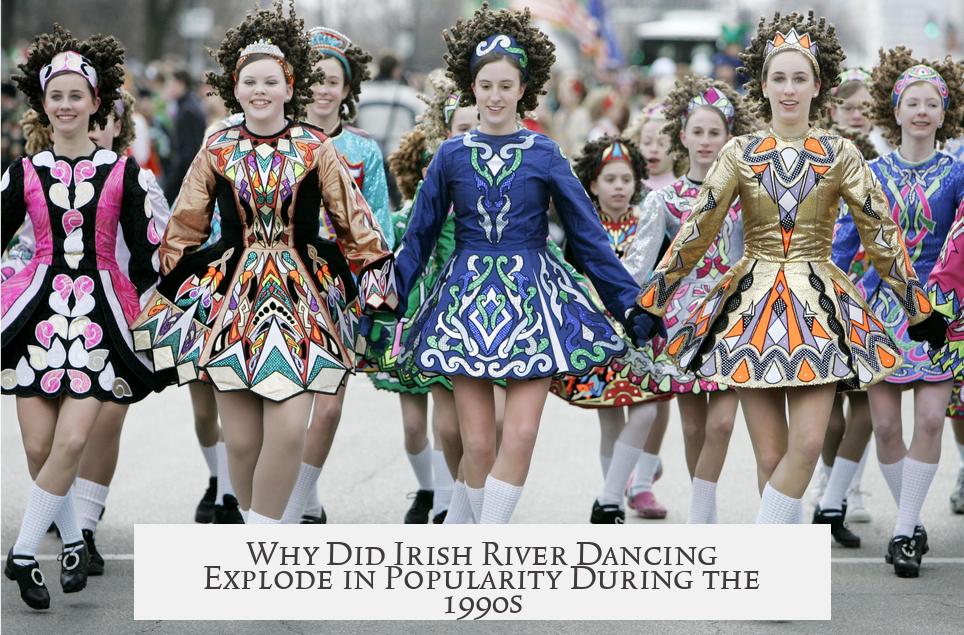
Irish River Dancing exploded in popularity during the 1990s because it transformed a centuries-old traditional dance into a dazzling, globally captivating spectacle at exactly the right cultural and economic moment. This was no accident; it combined history, timing, star power, and savvy marketing to make Irish step dancing cool, exciting, and culturally proud worldwide.
Let’s dive deep into the fascinating blend of history, culture, timing, and showbiz that fueled this global phenomenon.
Irish Step Dancing: From Underground Roots to a Cultural Revival
Irish step dancing is no new kid on the cultural block. Its history stretches back centuries, deeply intertwined with Ireland’s struggles and revival efforts. For roughly 400 years, during the “Penal Days” starting around the 1600s, expressions of Irish culture—including dance—were suppressed by oppressive authorities. This repression pushed many traditional dances underground, much like how the Scots’ tartans were once banned.
Yet, despite this, dance masters carried the torch. By the 1750s and through the Gaelic Revival, Irish dance was getting formally recognized again. And tradition thrived at a grassroots level with dances intricately tied to folk stories and rhythms like jigs and reels. Solo step dancing was just one form; team dances called “ceili” were also widespread, mirroring Scottish group dances.
Before Riverdance, these dances flourished in Irish communities with a strong competitive scene. The “Worlds” (Oireachtas Rince na Cruinne) event, hosted by An Coimisiún Le Rincí Gaelacha (CLRG), brought dancers from all over to compete yearly. Founded in 1927, CLRG unified competing cultural interests, ensuring that Irish dance stayed a vibrant, if niche, tradition. Honors went to elaborate costumes, regional tunes, and even childhood memories of grandparents playing spoons while families danced at local ceilis.
Riverdance: Turning Tradition into a Global Sensation
Then came Riverdance. It changed everything. Suddenly, Irish step dancing wasn’t an “uncool” extracurricular activity but a Broadway-worthy performance complete with stunning lighting, glossy costumes, and modernized rhythms. The traditional tin whistle, drum, and fiddle stayed, but the music and choreography were updated to electrify audiences.
The secret behind Riverdance’s success’ is not just that it looked flashy. Think of it as a perfect storm: a retinue of world champion dancers, a celebrated choreographer, the hauntingly beautiful voices of Anuna, and infectious, skillfully-produced music. Add to that the show’s premiere as the interval act at the 1994 Eurovision Song Contest—a frenzied, massively-watched event—and *boom*—Riverdance took the world by storm.
Crucially, the timing could not have been better. Ireland was in the midst of the “Celtic Tiger” economic boom. With newfound prosperity came fresh pride in Irish heritage. Suddenly, Irish culture was not something to hide but to flaunt. Riverdance put that pride on center stage, showing the glamour and vitality of Irish culture on a global platform.
A Dash of Star Power and Marketing Magic
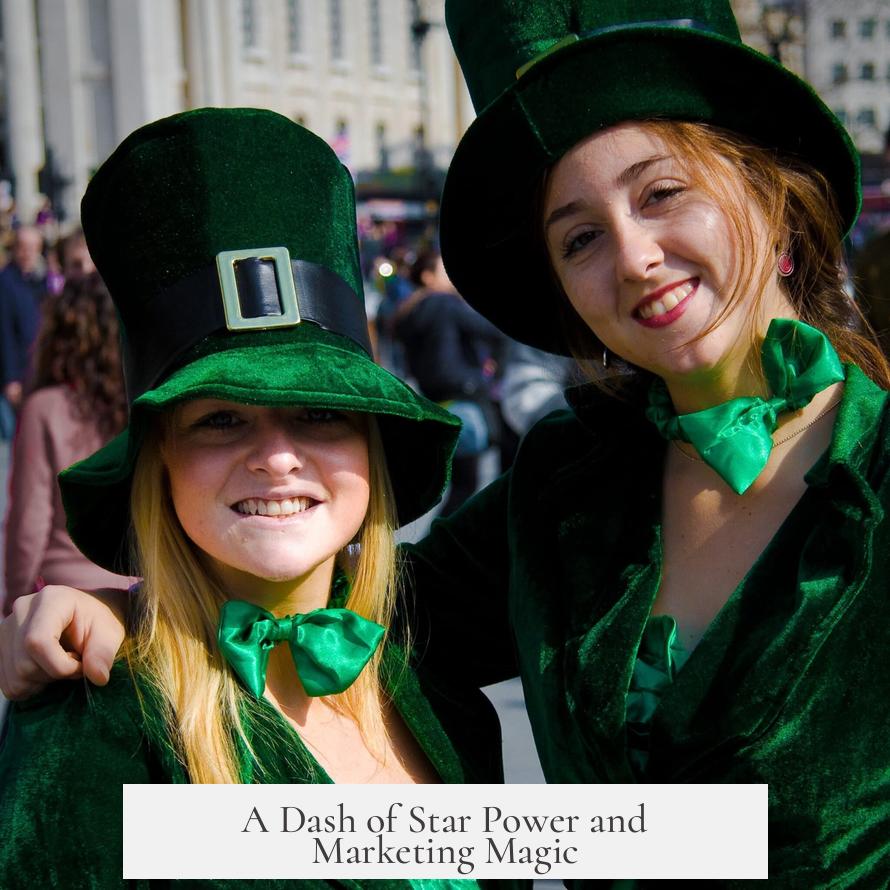
The brains behind the operation, including Broadway producer Miles Copeland, brought high-caliber marketing experience from working with the likes of Sting and The Police. The transformation of a brief Eurovision interval act into a full-length show was a brilliant move.
And then there’s Michael Flatley—the man many credit with pushing Irish dance into the stratosphere. An American of Irish descent himself, Flatley brought not only extraordinary talent but also showmanship that brought “sexy” and “flashy” to the genre. When he later launched Lord of the Dance, he amplified these qualities further, cementing step dance in popular entertainment globally.
Flatley’s American roots mattered. The United States has a vast Irish diaspora, celebrating St. Patrick’s Day with massive parades in cities like New York and Chicago. Flatley tapped into this cultural pride and nostalgia, turning Irish dance into a mainstream spectacle that could draw audiences far beyond traditional folk gatherings.
Eurovision: The Perfect Launchpad
It’s not mere coincidence that Riverdance debuted during Eurovision—a contest with immense cultural significance for European audiences, regularly drawing hundreds of millions of viewers. In the early ‘90s, Ireland was dominating Eurovision, winning three times in a row by 1994 and hosting again in 1996.
For its 1994 hosting duties, Ireland shifted the contest from a modest rural venue to the larger, urban Point Theatre in Dublin’s docklands—an area symbolizing urban renewal and growth. Riverdance took inspiration from the nearby River Liffey—a metaphor for urban regeneration and cultural flourishing—and echoed Ireland’s evolving identity. This metaphor resonated with both Irish and global viewers.
Eurovision’s massive exposure amplified Riverdance: audiences worldwide saw Irish dance in a way they’d never seen before—vibrant, polished, and emotionally powerful. It was a proud moment for Irish culture, projected on a global stage.
Riverdance’s Enduring Legacy
Riverdance did more than just entertain—it rejuvenated Irish step dancing. Suddenly, studios popped up worldwide. Today, the CLRG has competitive branches in 26 countries, from Asia to South Africa. Dance teachers trained in ballet or Highland dance took up Irish step dancing, spreading its appeal even further.
Riverdance’s boom eventually quieted as economic trends shifted and new entertainment trends emerged. Still, the dance’s reinvention has stuck—it’s bigger, global, and more accessible than ever. Young dancers no longer had to hide their passion; Riverdance made Irish dancing “cool” and gave many a sense of cultural pride and connection.
As a personal note, dancers from the 1990s cohort recall the excitement vividly. Where local competitions once felt nerdy or niche, suddenly pubs, schools, and theaters wanted professional-quality shows. Dance costumes got fancy, choreography got bolder, and every step gained new meaning.
Summing It All Up: Why Did Irish River Dancing Explode in the 1990s?
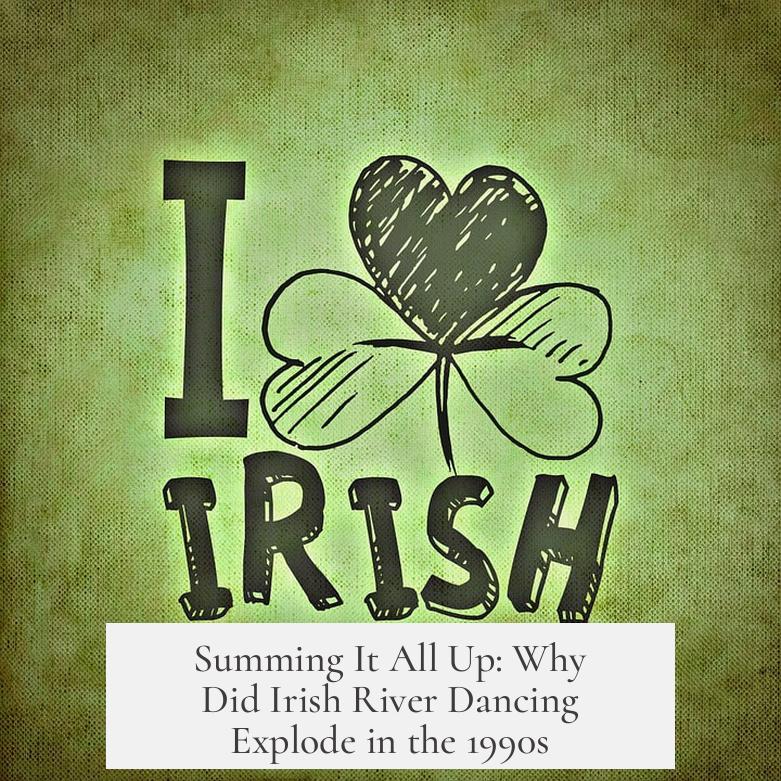
- Economic and Cultural Renaissance: Ireland’s “Celtic Tiger” era sparked a surge of national pride, fueling interest in showcasing Irish heritage to the world.
- Eurovision as a Global Spotlight: With Ireland’s strong Eurovision wins and hosting role, the Riverdance performance reached a massive, captivated international audience.
- American Connection and Marketing Prowess: Michael Flatley’s American Irish heritage helped penetrate the vast U.S. market. Coupled with savvy Broadway-level marketing, it skyrocketed to worldwide fame.
- Transformation of Tradition: Riverdance reimagined folk dance as a glamorous, dynamic theatrical experience that appealed to modern tastes.
- Global Legacy and Continued Growth: The post-boom explosion of Irish dance schools internationally has kept the tradition alive and evolving.
So, What Can We Learn?
Irish Riverdance’s phenomenal rise wasn’t a fluke or a simple matter of luck. It was a perfect convergence of cultural renaissance, economic timing, cultural pride, and media savvy. It proves that traditional culture, when reimagined and skillfully presented, can captivate global audiences—even in the shadow of pop culture’s constant churn.
And it also shows the power of performance to connect people—across continents, generations, and cultures—through the joy of movement and music.
Next time you hear the iconic tapping and swirling sounds from a Riverdance stage, remember: what seems like a flashy show is really a brilliant revival of centuries of rich, soulful cultural history.
What role did the Eurovision Song Contest play in Riverdance’s popularity?
Riverdance debuted as the interval act during Eurovision 1994. The contest had a massive audience. Its unexpected energy and style caught viewers off guard, giving Irish dancing huge exposure worldwide.
How did the Celtic Tiger economic boom influence Riverdance’s rise?
The Celtic Tiger boosted Irish pride and interest in heritage. With the economy growing, there was more investment in culture. This environment helped Riverdance attract international attention and resources.
Why was Riverdance considered a transformation of traditional Irish dance?
It added modern production values, lighting, and costumes. The music was enhanced but kept traditional instruments. This made Irish dance more appealing and accessible to broader audiences.
How did Michael Flatley’s involvement affect the dance’s popularity?
Flatley brought star power and showmanship. After Riverdance, he created Lord of the Dance, pushing the style to be flashier and more theatrical, keeping global interest alive.
What was the impact of Riverdance on Irish dance worldwide?
It sparked a major increase in dance schools globally. Organizations like CLRG expanded competition internationally. Irish dance is now taught and performed in over 26 countries, extending its reach far beyond Ireland.
